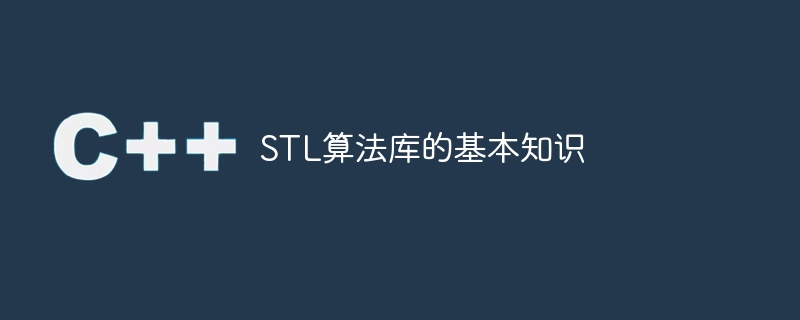Home >Backend Development >C++ >Basic knowledge of STL algorithm library
Basic knowledge of STL algorithm library
- WBOYWBOYWBOYWBOYWBOYWBOYWBOYWBOYWBOYWBOYWBOYWBOYWBOriginal
- 2023-08-22 17:34:451061browse

Basic knowledge of STL algorithm library
STL, the abbreviation of Standard Template Library, is one of the most commonly used template libraries in C. STL contains many important components such as containers, algorithms, and iterators, which can help developers save a lot of time and energy. This article will introduce the basic knowledge of the STL algorithm library.
1. Basic overview of algorithm library
The STL algorithm library provides rich and powerful algorithms, such as sorting, search, copy, delete, transform, merge, etc. These algorithms are designed to be independent of data containers, which means that you can switch between different data containers and use these algorithms without rewriting the algorithms.
The design idea of the STL algorithm library is to separate general algorithms from data structures. This design idea can better realize the reuse of algorithms, and also greatly improves programming efficiency for programmers. Therefore, the STL algorithm library can be used in different application scenarios, such as sorting, search, binary trees, graph frameworks and other fields.
2. Common classifications of STL algorithm libraries
In order to facilitate use and understanding, STL algorithm libraries are usually divided into the following 6 categories:
- Non-modified sequence operations Algorithms: These algorithms do not modify the elements in the data container, including search, counting, matching, etc.
- Modify sequence operation algorithms: These algorithms will modify the value of the elements in the data container (can be understood as "write" or "change", so it should not be used on constant sequences), including copy, delete, Replacement etc.
- Sort and related operation algorithms: These algorithms are used to sort sequences.
- Numerical algorithms: These algorithms are used to process numerical sequences, including arithmetic calculations, searches, etc. on numerical sequences.
- Commonly used algorithms: These algorithms are frequently used, such as certain pattern search algorithms, search algorithms, interval summation, average, etc.
- Container operation algorithms: These algorithms are designed to connect containers, such as swapping, merging, and sorting containers.
3. Commonly used functions in STL algorithm library
- sort() function
sort() function is the most commonly used function in STL algorithm library One of the sorting functions, which is used to sort the elements in a container. The commonly used parameter format of sort() is as follows:
sort(start_iterator, end_iterator, cmp);
where start_iterator and end_iterator are iterators pointing to the container, and cmp is a comparison function. The function of the cmp function is to compare two elements and return true if the first element is less than the second element, otherwise it returns false. If the cmp function is not specified, the sort() function will perform the default ascending sort.
- find() function
The find() function is one of the most commonly used search functions in the STL algorithm library. It is used to find specified elements in the container. The commonly used parameter format of find() is as follows:
find(start_iterator, end_iterator, value);
where start_iterator and end_iterator are also iterators pointing to the container, and value is the element to be found. If the element is found, the position of the element (that is, the iterator) will be returned, otherwise the end() iterator of the container will be returned.
- accumulate() function
The accumulate() function is one of the commonly used numerical functions in the STL algorithm library. It is used to sum a sequence of numerical elements. The commonly used parameter format of accumulate() is as follows:
accumulate(start_iterator, end_iterator, start_value);
where start_iterator and end_iterator are also iterators pointing to the container, and start_value is the specified initial value. The main function of this function is to sum the elements in start_iterator and end_iterator and return the result.
4. Summary
The STL algorithm library provides a very rich and powerful algorithm, covering many common scenarios and enhancing the development efficiency of programmers. This article introduces the basic knowledge of the STL algorithm library, including the basic classification of the algorithm library, commonly used functions, etc. I hope that readers will have a better understanding and mastery of the STL algorithm library and provide help for future development work.
The above is the detailed content of Basic knowledge of STL algorithm library. For more information, please follow other related articles on the PHP Chinese website!

